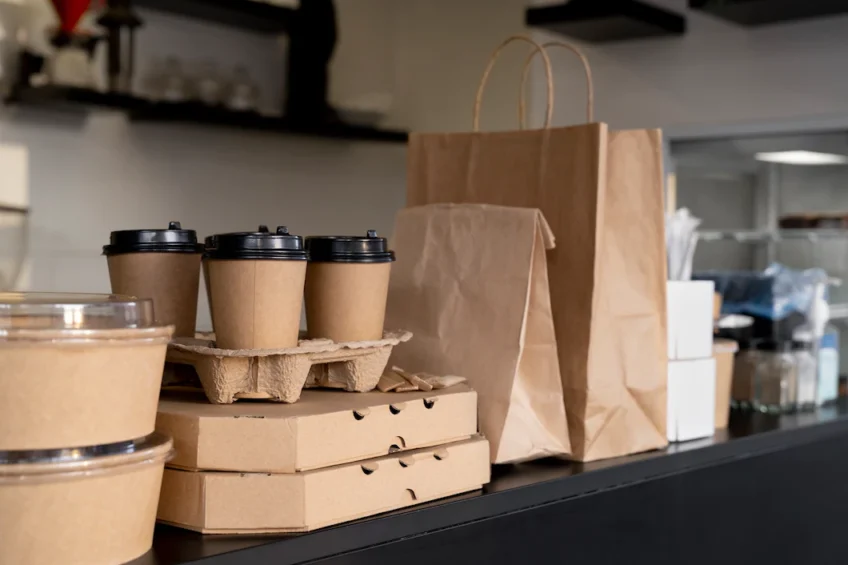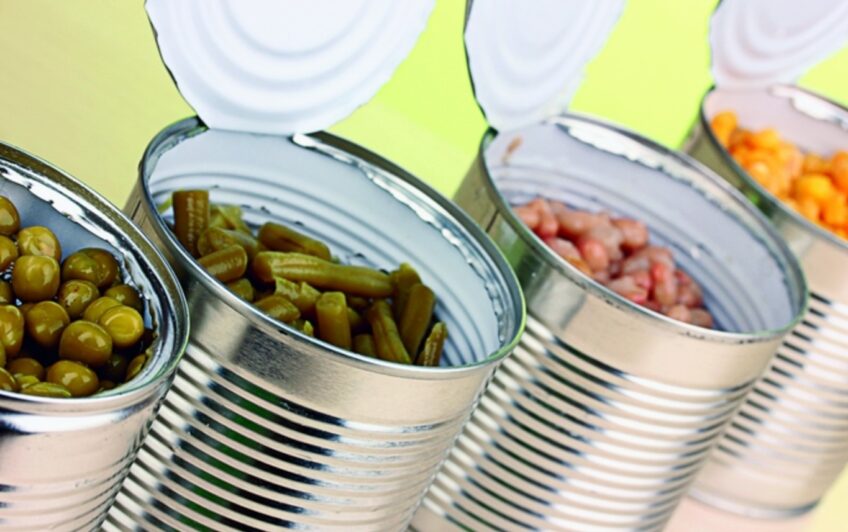THE GIST
What is the problem?
Bisphenol A (BPA) is an endocrine disrupting chemical used in the lining of many food and beverage cans. Studies have shown that BPA can leach from the lining of cans into the food and then into people. Growing consumer concern over BPA’s health impacts has increased demand for BPA-free products and food packaging. Unfortunately the identity of the replacement chemicals is often not disclosed and the safety of the BPA-alternatives we do know are being used is unknown. For example, BPA in some baby bottles and receipt paper has been replaced by other bisphenols such as BPS and BPAF. Studies have shown that these chemicals are also endocrine disruptors.
What did they do in this study?
Scientists from Tufts University School of Medicine worked with the can lining manufacturer Valspar to independently test Valspar’s new can lining material for estrogenic activity. They looked at both the final material and the “monomer” used to create it. They also assessed if the material could leach into foodstuffs from the final coating polymer. On January 13, 2017, Dr. Ana Soto, the lead author, published their findings in Environmental Science & Technology in a paper entitled: “Evidence of Absence: Estrogenicity Asessment of a New Food-Contact Coating and the Bisphenol Used in its Synthesis.”
What did they find?
The material (TMBPF) did not show estrogenic activity in the assays they used – not in receptor binding assays, cell studies or whole animal studies – there was no effect on uterus weight in females, puberty in male or female rats or mammary gland development in female rats. When they looked for leaching from the final coating, they could not detect any migration with a 0.2 parts per billion detection limit. As the researchers conclude, “their findings provide compelling evidence for the absence of EA by TMBPF and the polymeric coating derived from it, and that human exposure to TMBPF would be negligible.”
The Backstory on BPA in Food Can Linings

Why do we care?
The Breast Cancer Fund is no stranger to spearheading campaigns that grow consumer demand for non-toxic consumer products in order to grow the marketplace of safer products.
The Campaign for Safe Cosmetics, a project of the Breast Cancer Fund, has proven that as consumers learn more about the toxic chemicals they are being exposed to in everyday items, the potential health impacts and the lack of federal oversight, they “vote” with their pocketbooks, demanding safer personal care products for themselves and their families. And the market listens. Today, the safe/natural sector of the multi-billion dollar cosmetics industry is $19 billion and growing.
Another success story that illustrates the ability of consumers to move markets was the industry exodus away from the use of bisphenol A (BPA) in baby bottles, sippy cups, sports water bottles and canned infant formula.
This market flight was fueled by public outrage over the widespread use of BPA in food packaging despite a growing number of scientific studies linking exquisitely small amounts of BPA exposure to a staggering number of health problems including breast and prostate cancer, asthma, obesity, behavioral changes (including attention deficit disorder), altered development of the brain and immune system, low birth weight and lowered sperm counts.
In all, five U.S. cities and counties, 13 states and ultimately the FDA banned BPA from baby bottles, sippy cups and infant formula cans. But with this important consumer victory – and flexing of consumer muscle – came a sobering wake-up call to a troubling phenomenon called “regrettable substitution” – the replacement of one toxic chemical with an equally or more toxic alternative.
In the case of BPA in baby bottles, “regrettable substitution” was not just a theoretical construct — it turned out to be a real-life problem. An assessment, published March 2011 in Environmental Health Perspectives (EHP), of more than 500 commercially available plastic products labeled BPA-free, found many to be leaching endocrine-disrupting chemicals that in some cases were more estrogen active (EA) than BPA-containing plastics.

That same year, the Breast Cancer Fund launched our Cans Not Cancer Campaign, designed to generate the public will necessary to similarly drive BPA out of the lining of canned foods with a parallel goal of increasing consumer demand for safer alternatives. The battle cry for informed substitution was further fueled when three years later, in a follow-up study published in May 2014, the same researchers tested 50 BPA-free products and found similar results, warning “BPA-Free did not mean EA-Free.” [ii] Our new mantra became: Consumers want BPA-free canned food that is truly safer, not canned food lined with chemicals that are equally or more estrogenic.
For 5 years we knocked on the doors of the world’s biggest multinational canned food manufacturers urging them to stop using BPA to line their food cans and adopt a higher level of transparency regarding the identity and the safety of the BPA alternatives they were using or moving toward.
As breast cancer prevention advocates, we petitioned the FDA to ban BPA from food packaging because of its estrogenic properties and links to a host of adverse health effects, we lobbied congress to do the same and we raised public awareness about the new science showing small amounts of endocrine disrupting compounds – like BPA – were being linked to breast cancer and other big health problems.
It is important to remember that the little FDA regulation of the food packaging industry that does exists, does not require manufacturers look for and rule out the use of chemicals in food packaging that display estrogenic activity or other endocrine disrupting properties. So as far as we could tell, no one was minding the store in terms of preventing the “next BPA” in food can linings from being just as estrogenic – or more – than BPA is.
And then something amazing happened. A chemical company named Valspar came knocking on our door and said they wanted to talk to us about a new BPA alternative they had developed with the catchy name tetramethyl bisphenol F (TMBPF). They told us that consumer concern with BPA, and its estrogenic properties had created demand for EA-free alternatives and prompted a 5-year journey on their part to meet that demand by inventing the safer BPA alternative that breast cancer prevention advocates and others were asking for.
We had never been visited by a chemical company before and at first we were suspicious. But we were quickly impressed by not only the extensive testing they had conducted – not just for estrogenic activity, but for other types of hormone disruption and other adverse outcomes such as organ toxicity and genotoxicity. We were also impressed by their willingness to share that safety data with us and by the new model for safety substantiation they used in the creation of TMBPF called “Safety by Design.”

Safety by Design is a safety protocol that requires testing for endocrine activity, along with other more traditional toxicological testing hazard endpoints, not because the FDA requires it but because it is a source of public concern. Equally amazing is the Safety by Design commitment to “put (Valspar’s) new coatings to the test in the hands of recognized independent scientists, many of whom previously identified health concerns for the very products we seek to replace.”
Thus, the independent safety testing of TMBPF for estrogenic activity by renowned breast cancer scientist – Dr. Ana Soto and the choice of Dr. Maricel Maffini, another renowned scientific expert on breast cancer and a member of our Science Advisory Panel, as a primary consultant on this project.
We applaud the publication of Dr. Soto’s peer-reviewed article which affirms TMBPF is not estrogen-active. Dr. Soto’s paper links to Valspar’s website which provides full reports evaluating potential migration, transactivation, uterotrophic and pubertal assays. Valspar’s level of transparency is also to be applauded. However to be completely confident of the overall safety of this new material, it is important for Valspar to go a step further and make available its safety data related to additional health endpoints and environmental toxicity.
The arrival of TMBPF is exciting to be sure, and deserves the attention of – and close inspection by – the big multinational food giants as well as advocates in the environmental health and justice communities. Also deserving of attention is Valspar’s “Safety by Design” which raises a high bar – and creates a model – for the safety testing of chemicals in food can linings and other product sectors as well. In this time of uncertainty regarding whether the federal government will be the caretaker of public health we need it to be, it is heartening to see Valspar stepping up, and in the process of doing so, challenging other chemical companies to be responsible stewards of public health.

